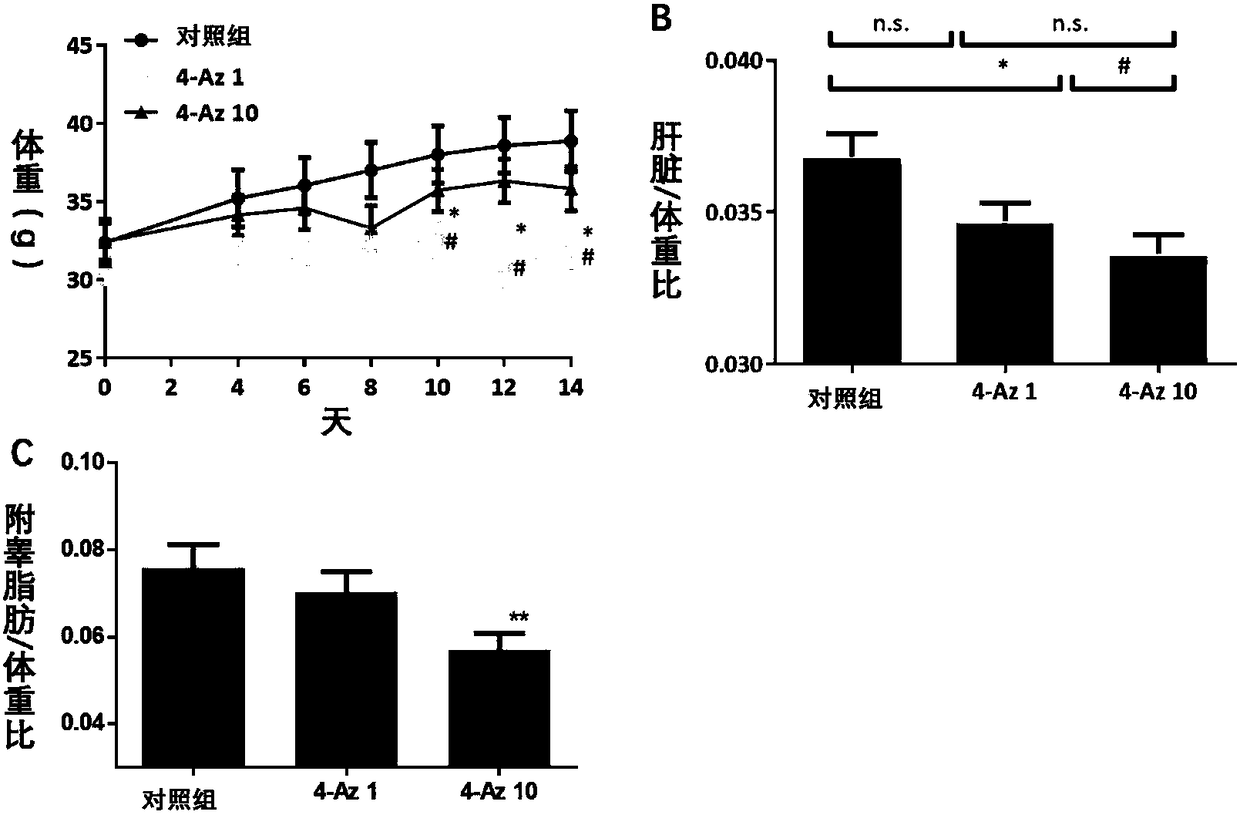Use of nitrine phlorizin in preparing drug for treating non-alcoholic fatty liver disease
A non-alcoholic, nitrogenated phlorizanin technology, applied in the field of medicine, can solve problems such as 4-AzGGPPS protein that has not been shown in research, and achieve the effect of protecting liver function, reducing lipid accumulation, and lowering levels
- Summary
- Abstract
- Description
- Claims
- Application Information
AI Technical Summary
Problems solved by technology
Method used
Image
Examples
Embodiment 3
[0046] Example 3, 4-Az promotes ubiquitination and degradation of GGPPS
[0047] After administration of 4-Az, the ubiquitination-proteasome inhibitor MG132 and the lysosome-autophagosome fusion inhibitor CQ were treated respectively. When the two degradation pathways were respectively destroyed, only the treatment of MG132 prevented the expression of GGPPS decline. And the expression of GGPPS increased with the increase of MG132 concentration. We therefore concluded that the ubiquitination-proteasome inhibitor MG132 was able to reverse the decrease in GGPPS expression caused by 4-Az. The 293T co-transfected with GGPPS and Ub plasmids were divided into four groups: negative control group (DMSO), drug treatment group (4-Az, 10uM), proteasome inhibition group (DMSO+MG132), proteasome and drug combined Group (4-Az+MG132). MG132 prevents degradation by preventing the entry of target proteins tagged with ubiquitinated small molecules into the proteasome. When 4-Az and MG132 tre...
Embodiment 4、4
[0048] Example 4, 4-Az can directly bind to the mode of action of GGPPS
[0049] The concentration of the purified GGPPS-EGFP-His fluorescently expressed fusion protein was kept constant, and the concentration of the titrant used in each titration, that is, the concentration of FPP, the GGPPS positive control substrate, was changed. The thermophoretic movement of unbound GGPPS is different from that of the substrate FPP bound to GGPPS. The time shown is t=30 seconds. At different FPP concentrations, the normalized fluorescence signal of GGPPS is formed at Kd Fitted binding curve. The titrant was replaced with the natural active small molecule that needs to be identified. Compared with the control group EGFP, the fluorescence detection showed that 4-Az was directly combined with GGPPS. It can be seen that 4-Az promotes the degradation of GGPPS by directly combining with GGPPS to promote the ubiquitination of GGPPS.
[0050] Therapeutic effect of phlorizin azide on non-alcohol...
Embodiment 1
[0062] Embodiment 1, establishment of non-alcoholic fatty liver mouse model
[0063] Establishment of non-alcoholic fatty liver model mice by food-induced induction. The 4-week-old mice mentioned above in "General Materials and Methods" were fed with high-fat diet (containing 60% fat) for 8 weeks, and fatty liver was successfully induced after 8 weeks.
PUM
 Login to View More
Login to View More Abstract
Description
Claims
Application Information
 Login to View More
Login to View More - R&D
- Intellectual Property
- Life Sciences
- Materials
- Tech Scout
- Unparalleled Data Quality
- Higher Quality Content
- 60% Fewer Hallucinations
Browse by: Latest US Patents, China's latest patents, Technical Efficacy Thesaurus, Application Domain, Technology Topic, Popular Technical Reports.
© 2025 PatSnap. All rights reserved.Legal|Privacy policy|Modern Slavery Act Transparency Statement|Sitemap|About US| Contact US: help@patsnap.com



